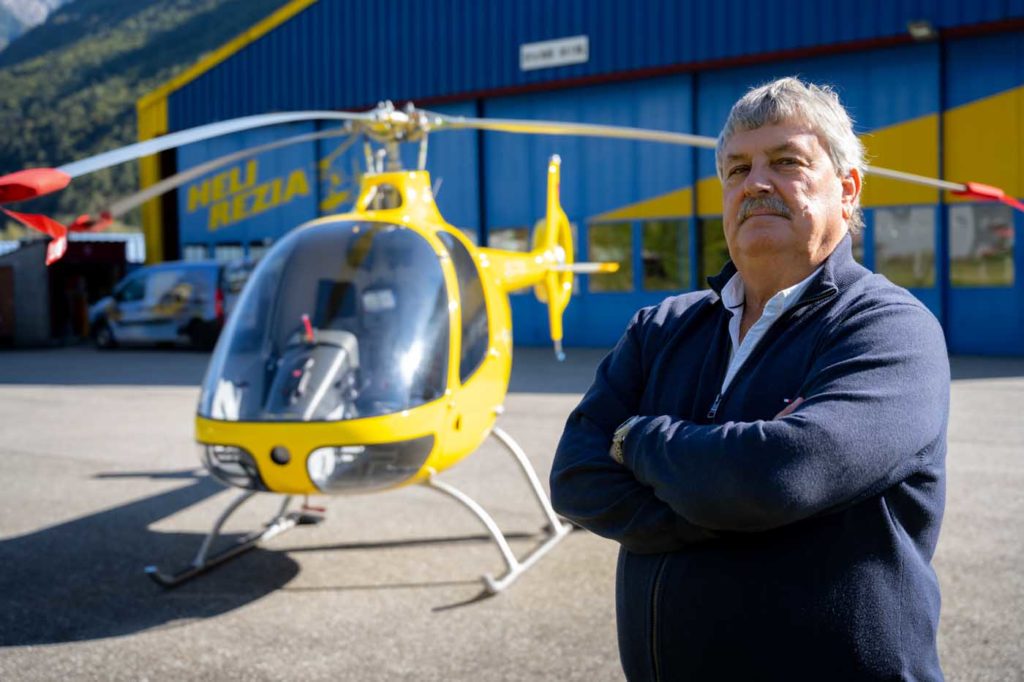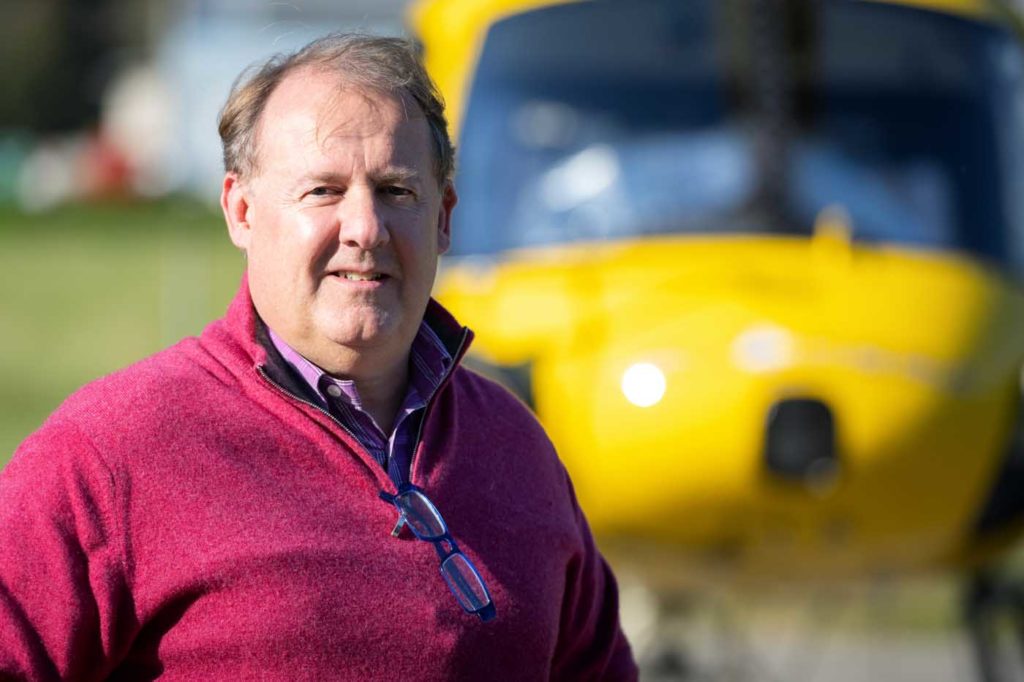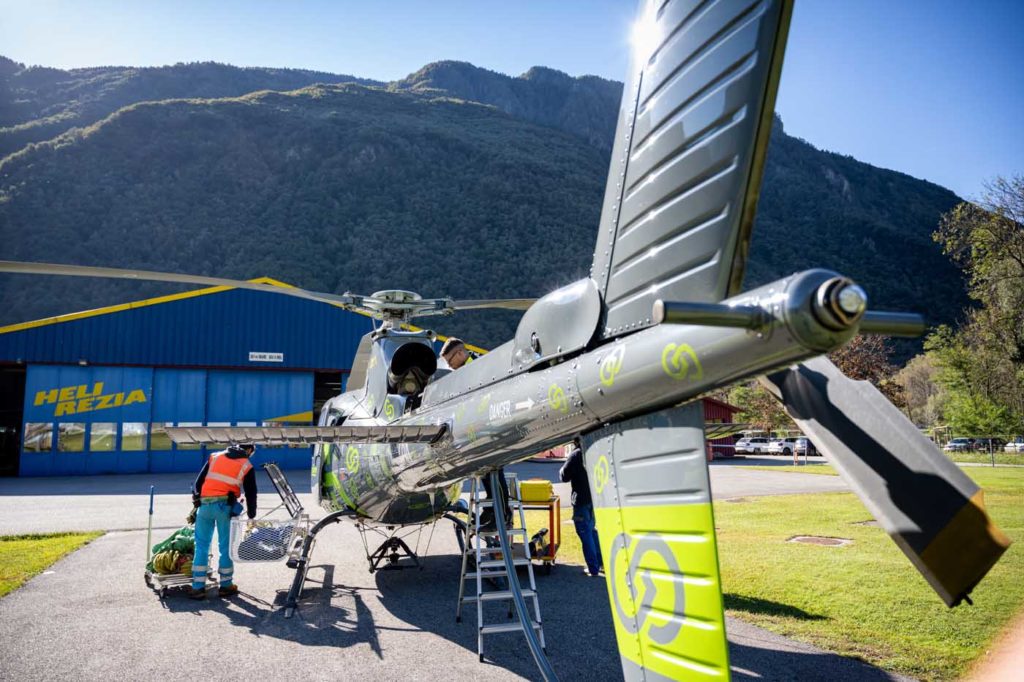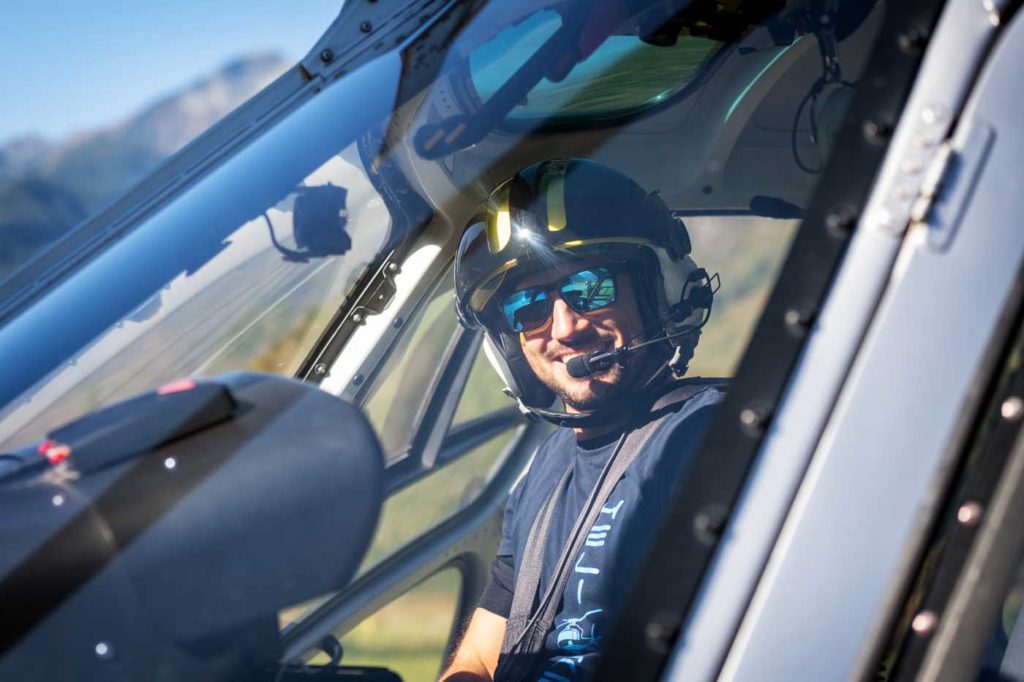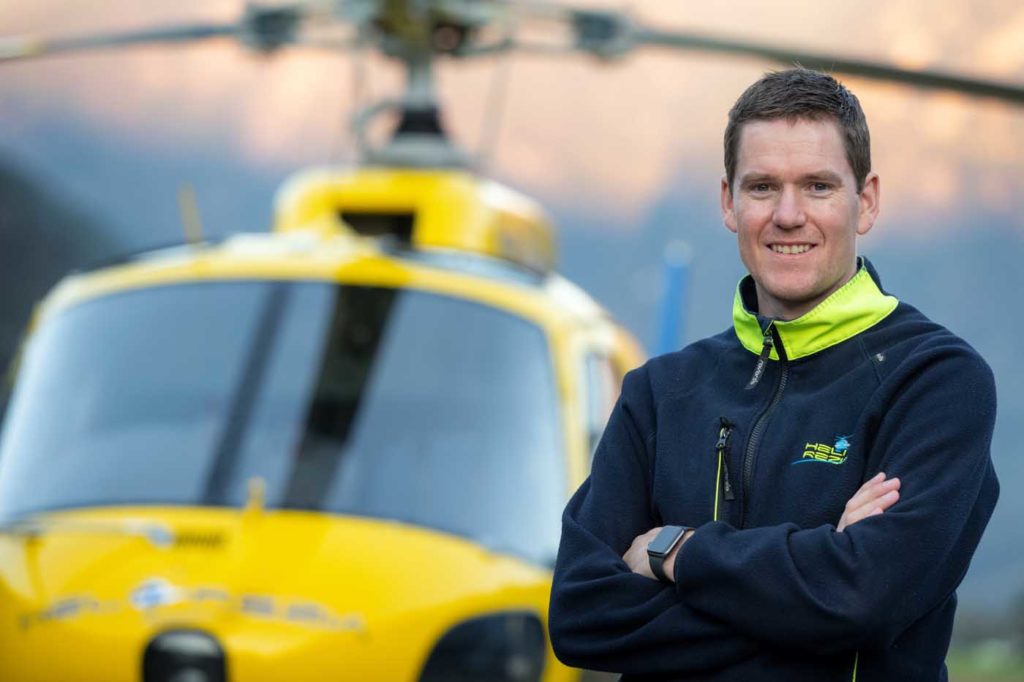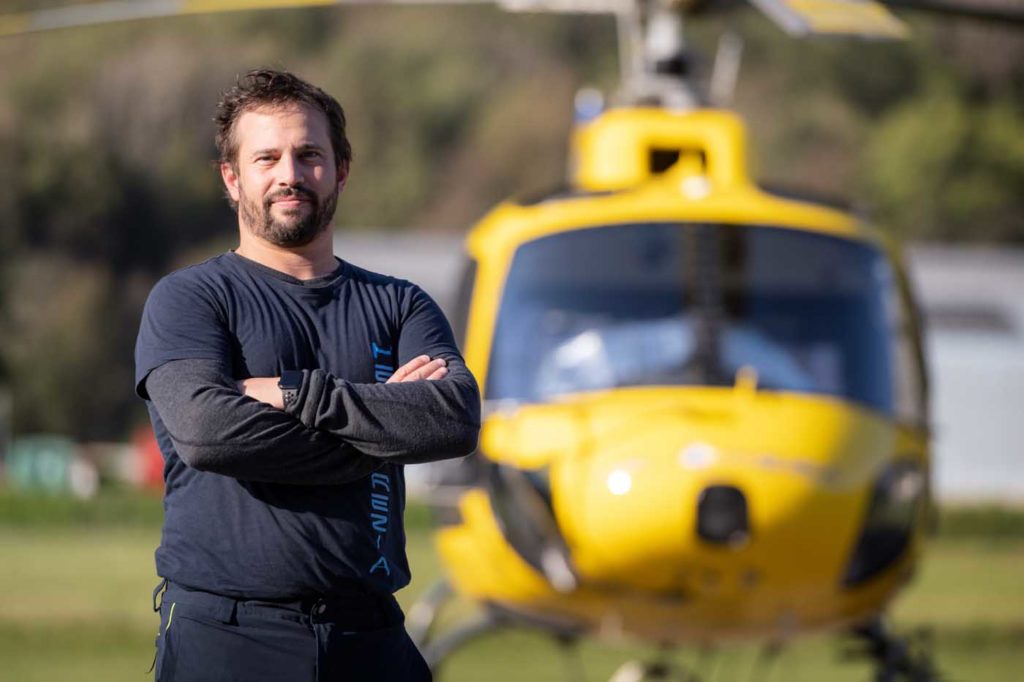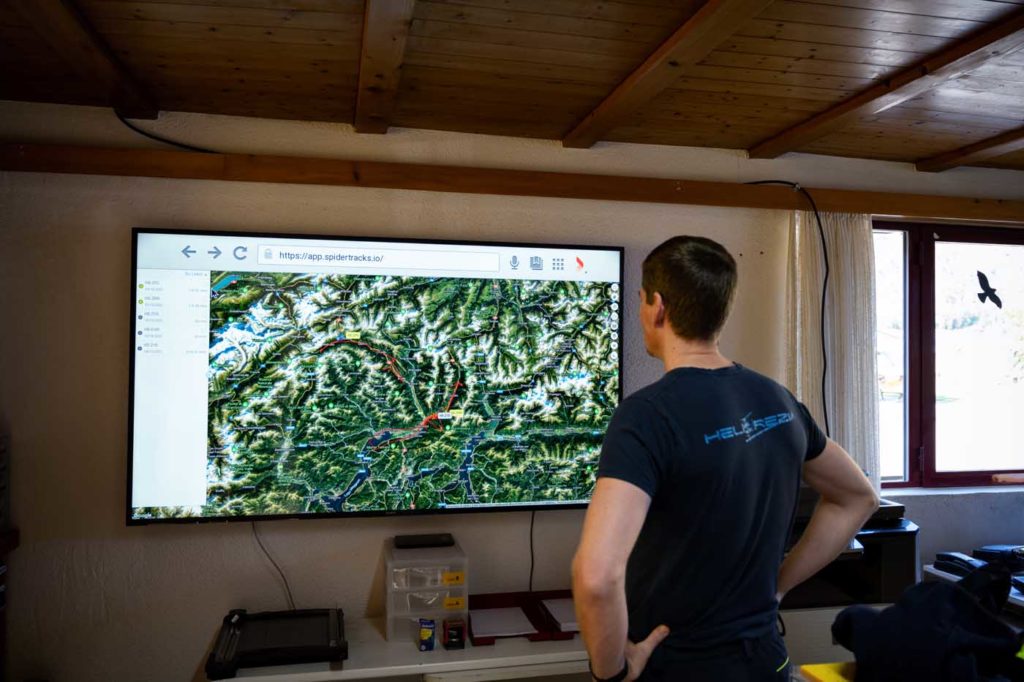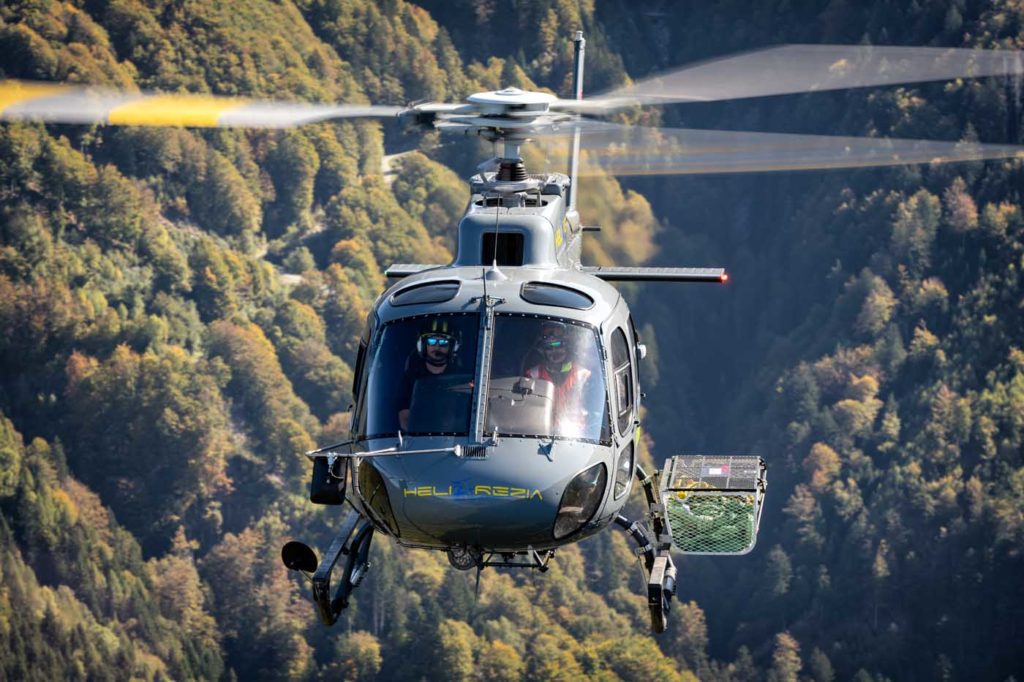Photos by Lloyd Horgan
People come from all over the globe for the positive well-being effects for which Switzerland is famous. Whether it’s climbing or skiing in the mountains, relaxing in alpine spas, or through the world-leading life-sciences industry of “health valley,” the country has a reputation for both peacefulness and vitality. Beautiful snow-capped peaks soar into the clouds, while the valley pastures bathe in sunshine. Little wonder that the Swiss enjoy some of the highest living standards in the world.
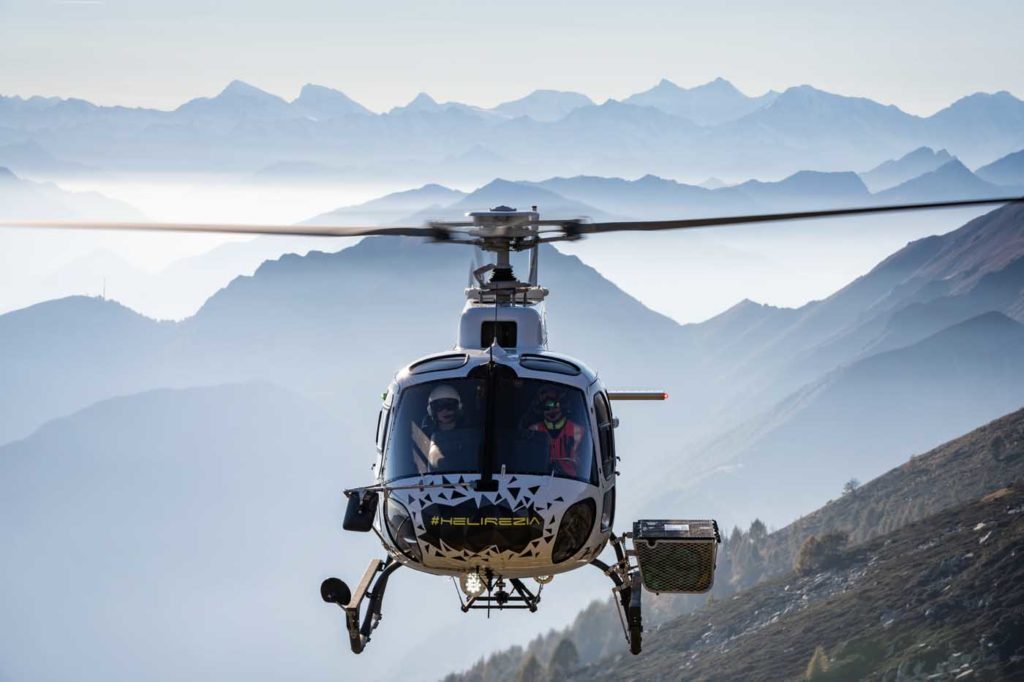
But the wealthy guests sustaining this economy are accustomed to a lifestyle that is difficult to provide on top of a mountain. This is where Heli Rezia steps in. Since 1989, the company has been providing the means to support modern life at altitude, whether that is public utilities or private luxuries.
“The company grew out of the passion of a few professionals and entrepreneurs,” Renato Belloli, Heli Rezia’s CEO, told Vertical. His family name is prominent in the construction industry in the region, particularly producing avalanche protection structures. “We would normally have a helicopter to transport the anti-avalanche system up into the mountains, but we thought: ‘Why can’t we do this job ourselves?’ ”
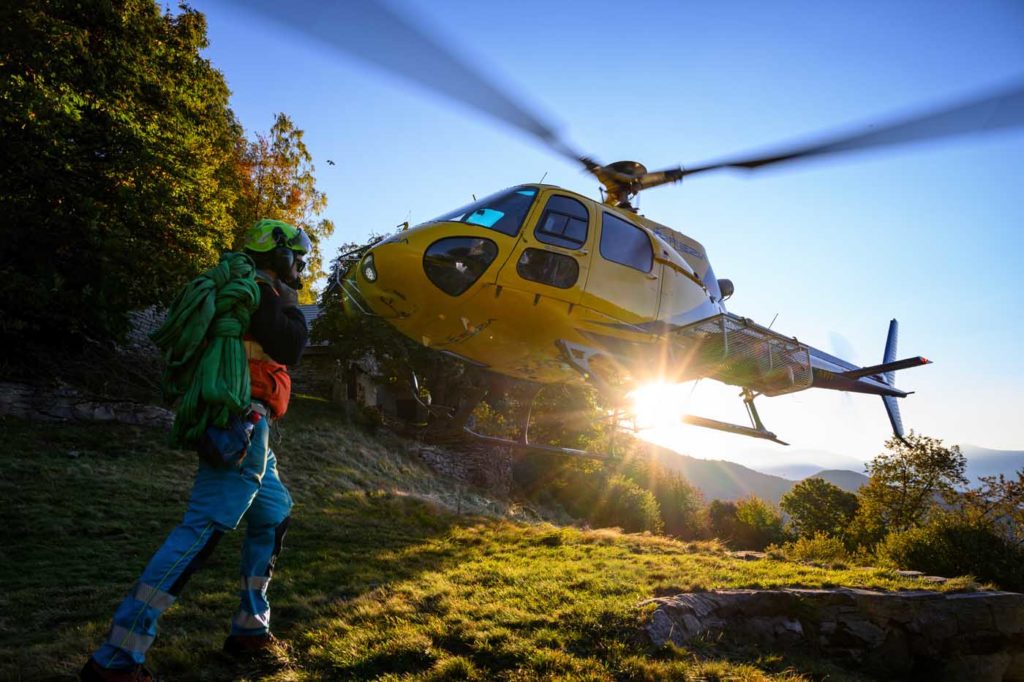
Heli Rezia was born shortly afterwards, and was soon using its own helicopters to sling-load equipment and material into locations unreachable by other means.
“In the beginning we were flying the old Llama,” said Belloli. “Now we fly the [Airbus] H125, which is a better, more modern helicopter for the job.”
“The job” Belloli is referring to is hinted at by the choice of aircraft.
The H125 is a popular choice among alpine operators and is well known for one thing in particular: its lifting ability.
While the company does work in different sectors, including managing two Leonardo AW109s for charter operations, the focus is unequivocally on sling-loading.
“We have three [Airbus Helicopters] H125s and one AS350 B2,” explained Hallvar Frey, one of the line pilots with Heli Rezia. “The H125 is the main aircraft that we use for sling operations because of its performance.”
After beginning his flying career in Norway and qualifying as an instructor in the U.K., Frey fell in love with sling load flying, which took him as far afield as Greenland and Chile before coming to work at Heli Rezia.
“I started here about two years ago and really enjoy working in Switzerland,” he said. “There are a lot of things here in a compact area. I can be sling loading at 8,000 feet [2,440 meters] in the mountains, and then go home for lunch five minutes from the base!”
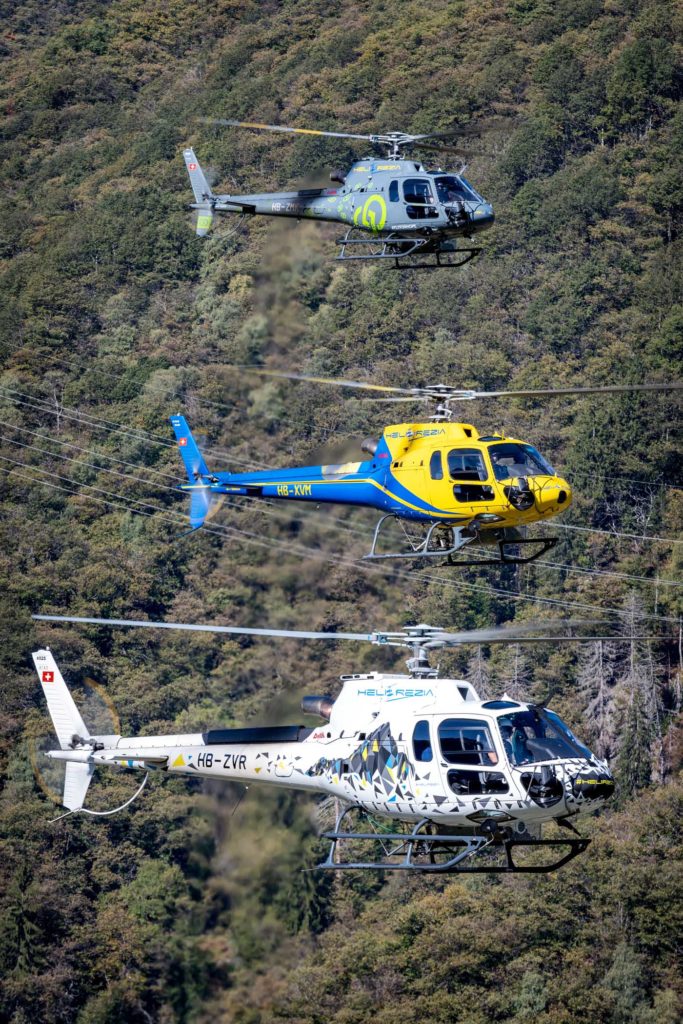
Heli Rezia has three bases spread across the southern region of Switzerland, where the mountains are most severe. Two of these are in the Italian-speaking region of Ticino.
“Typical sling-load tasks are moving big [construction] bags and materials for cabins, but we also do logging and firefighting, when there is a need for that,” said Frey. “The contracts for firefighting rotate between operators, so if I’m slinging when I get the call, I just stop the operation, go back and get the Bambi Bucket, and start firefighting.”
Heli Rezia also pioneered the use of helicopters for cleaning wind turbines, a business that it is seeking to restart.
“You fly with an operator on the right side next to the pilot, and he operates a big power washer on a long tube to wash the blade of the turbine,” explained Frey.

Most work, though, is sling-loading cargo. The Swiss economy depends on attracting wealthy visitors, so providing luxury items like pools to mountainside cabins is a staple activity.
“We typically fly about 30 jobs per day, so in the summer it can be quite busy,” said Frey. “We get a schedule from our dispatchers with all the clients sequenced and divided into sectors by region.”
The specialists
On most of these jobs, two task specialists will fly with the aircraft to the work site. They provide a vital link between the operation on the ground and the pilot.
“We work very closely with the task specialists and we are on the radio to them a lot,” explained Frey. “If I have a pool on the end of an 80-meter [262-foot] line, I can’t see much, so the task specialist will talk me down on the radio and we [can] be accurate to the centimeter [half an inch].”
On the other end of the line, workload is also high and teamwork no less important.
Davide Carpi is a task specialist with Heli Rezia. He explained the unique blend of technical theoretical knowledge, intuitive perception, and calm confidence required to be good at the job.
“You have to look at the location to understand how you can do the job without damaging anything,” he said. “But you also have to understand how the load will balance and where to put the ropes so that it is in the right position.”
The most often-repeated phrase heard when talking with Heli Rezia’s pilots and task specialists is “risk management.” Correctly judging and managing these risks on the fly depends on both doing their job in perfect harmony. Delivering large, unwieldy, and often extremely valuable and fragile loads demands a cool head from all involved.
“You have to be calm, manage the pressure and stress, and be able to deal with the unexpected,” said Carpi. “You learn a lot by doing, but you also have to do a lot of theoretical courses.”
Although the pressures on location sit on the shoulders of the task specialists and the pilots, the dispatchers play their part by ensuring that people are assigned to appropriate jobs.
“You start off doing simpler tasks with fewer hazards,” explained Carpi. “Then you build experience to do some of the more difficult jobs.”
The same approach applies to the pilots. While Marco Sartori is an experienced pilot and an instructor, he is still building his sling load experience, referred to by the European Union Aviation Safety Agency (EASA) as HESLO (Helicopter External Sling Load Operations).
“I did a few hours of HESLO early on, but then I didn’t touch a sling for a few years,” he said. “I did a HESLO training course with Volo Mission in Texas, but I didn’t get a break into HESLO work until I came here to Heli Rezia.”
Sartori was offered a route into a HESLO career at Heli Rezia in 2020. “My career has taken off like a rocket now!” he laughed. “Every second is another sequence that you must do correctly. I like the work a lot.”
While he relishes the challenges of flying the sling loading mission, Sartori also gives credit to the task specialists.
“In the summer with the warm wind it gets gusty in the mountains, but it is even more challenging in the city when you have a long sling and you have to put something in a small place,” he said. “The task specialists are like my brothers, we all want to come back with the job done and no issues.”
There is diversity, even within the HESLO tasks themselves, and they are divided into four categories. Each level permits more advanced operations or complex cargo, but requires specific training, proficiency checks and experience.
Level 1 tasks involve lines up to 20 meters (65 feet), while level 2 permits long lines over this length, and level 4 includes complex tasks such as tower erecting and wire stringing.
“We do a lot of different tasks in one day, from flying bags up to a cabin, to
HESLO 4 missions where you are mounting pylons somewhere,” explained Frey. “Most of the time it’s a combination of things, and you might even be doing some logging in between the HESLO jobs.”
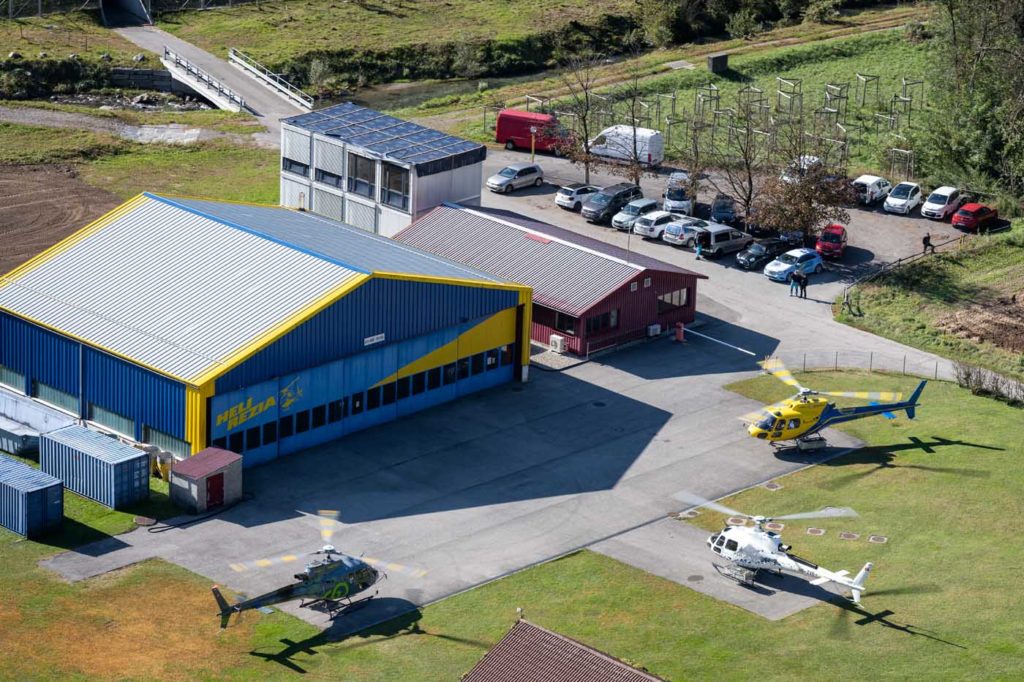
Coordinating all this activity is a complex job, and one that is done by a team of scheduling staff who will also strategically position teams of task specialists with fuel trucks.
In the past, a printed program would then be issued to each pilot for the day’s work, to which the pilot would then have to append important data such as load lifts, using a mechanical counter.
“We have moved to an online solution that is very customizable, and reduced the workload for the dispatchers and for the pilots,” said Frey. “We have all the information on the job preconfigured on a tablet computer, along with a map that shows wires and counters to record the number of lifts.”
“You have to look at the location to understand how you can do the job without damaging anything. But you also have to understand how the load will balance and where to put the ropes so that it is in the right position.”
Davide Carpi
Terrain, weather and the variety of the tasks give the pilots plenty to think about, even during a routine day’s work. The precision of the flying itself requires total concentration, so the reduction of anything superfluous to that aim is welcome, illustrated by Frey’s most recent task in Oberalp. Land vehicles can’t travel through this mountain pass during winter, because it can start snowing heavily there as early as October.
“The first thing about Oberalp is the altitude. The pickup and the drop-off were both between 7,500 and 8,000 feet [2,290 to 2,440 meters] so you are already quite high,” he explained. “The valley channels a lot of wind, so it can turn 180 degrees between the top and the bottom.”
The task involved lifting four pylons, the bases of which were over 1,980 pounds (900 kilograms), which meant carefully planning the fuel load.

“You want to try to get rid of as much weight as possible, but operate with a safe amount of fuel,” said Frey. “You do need a little extra margin at the top in case a bolt gets stuck, so that you’ve got some spare [performance].”
Are you experienced?
Frey plans particular profiles that allow him a safe area to put the cargo down, should a gust of wind catch him with a heavy sling load. Described in the calm of a hangar, it sounds like no big deal, but such habits are usually borne of either hard experience or rigorous training.
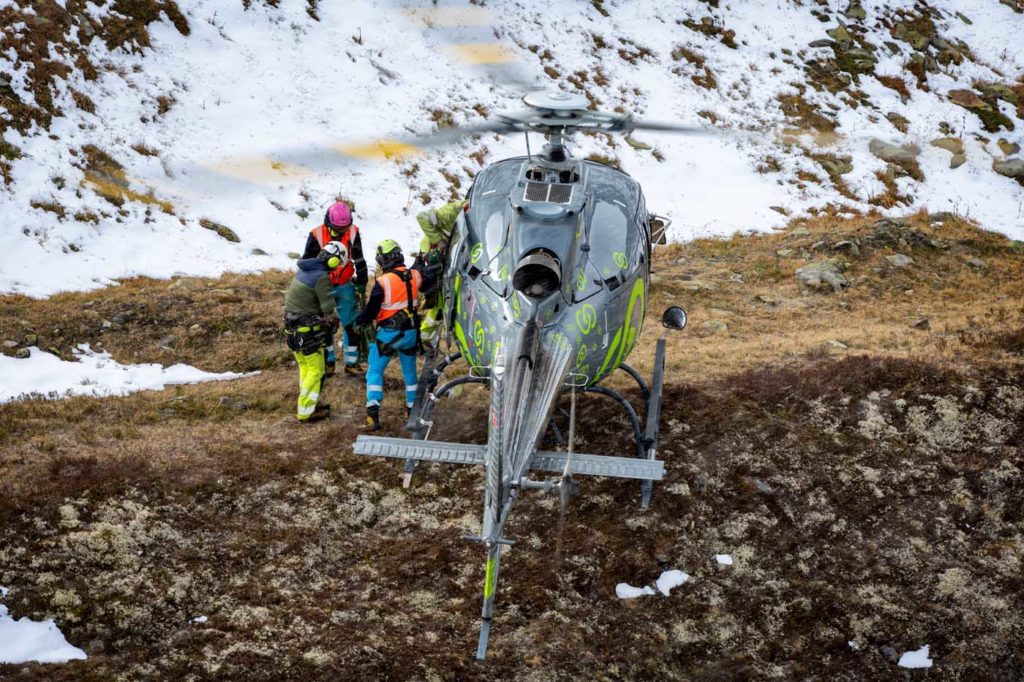
Renato Belloli believes in both, although he admitted that the outflow of experience from the industry was becoming a concern.
“It’s difficult to find good pilots with experience in the mountains with aerial work,” he explained. “We have experienced pilots, but we must be able to recruit younger pilots with the right experience.”
“We didn’t know whether we could succeed, but now we have four instructors and 12 students and we are very happy with that workload.”
Gianni Testa
Belloli and Heli Rezia are not waiting for a solution to find them. In 2019, the company founded its own flight school, using the Hélicoptères Guimbal Cabri G2.
“The Cabri is like a little H125,” laughed Belloli. “Our job in the mountains is very particular, and it’s important to train on a similar helicopter that pilots will fly in the future.”
While the Cabri is a good deal smaller than the H125, and has a piston engine, Belloli said it offered the right compromise of price over performance.
“With the Cabri we can do more or less all the HELSO training at a lower cost, and we can go from basic to 60-meter [195-foot] long line training,” he said. “We don’t need a large area either, because we focus on precision.”
Starting the school, Belloli was offered the assistance of Gianni Testa, a friend who had been flying since 1968 and had been planning to retire.
“It was like a bet!” joked Testa. “We didn’t know whether we could succeed, but now we have four instructors and 12 students and we are very happy with that workload.”
Testa explained that the school was equipped to provide private and commercial training, as well as EASA HESLO and Switzerland’s own mountain flying qualification.
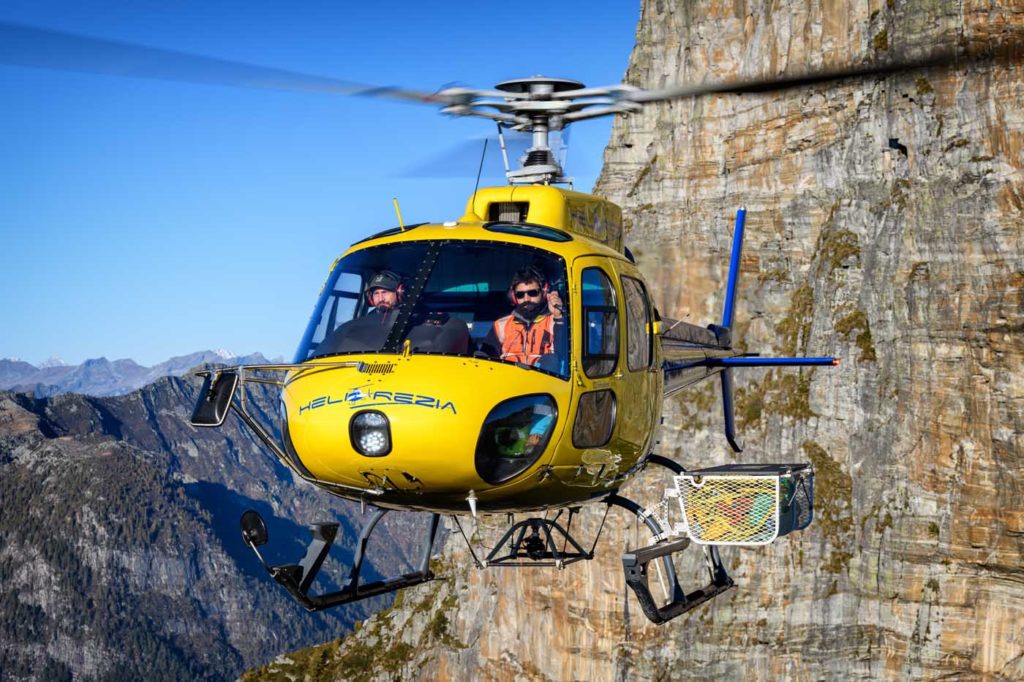
“The instructors are very experienced,” he explained. “And our base here is an old military airfield, so we can do everything without any waiting times.”
While the school aims not to stretch students’ wallets, it does need to be able to stretch their flying ability. For this, too, Switzerland’s geography provides.
“Looking around here you can see plenty of mountains,” said Testa. “It’s not an easy place; when the wind picks up in the valleys, it can be quite demanding for the students.”
While the Swiss topography provides value in simple things like a view, it also creates complicated problems that need skilled people to solve them. And the low-volume, high-value dynamic means they need to get the answer right the first time.
Heli Rezia knows the sort of people that can thrive under these circumstances don’t grow on trees; they must be cultivated.
“I enjoy having to make decisions quickly and manage the situation very fast, be really focused,” said task specialist Carpi. “It’s kind of a meditation, like when you are climbing, it’s really good for your mind.”
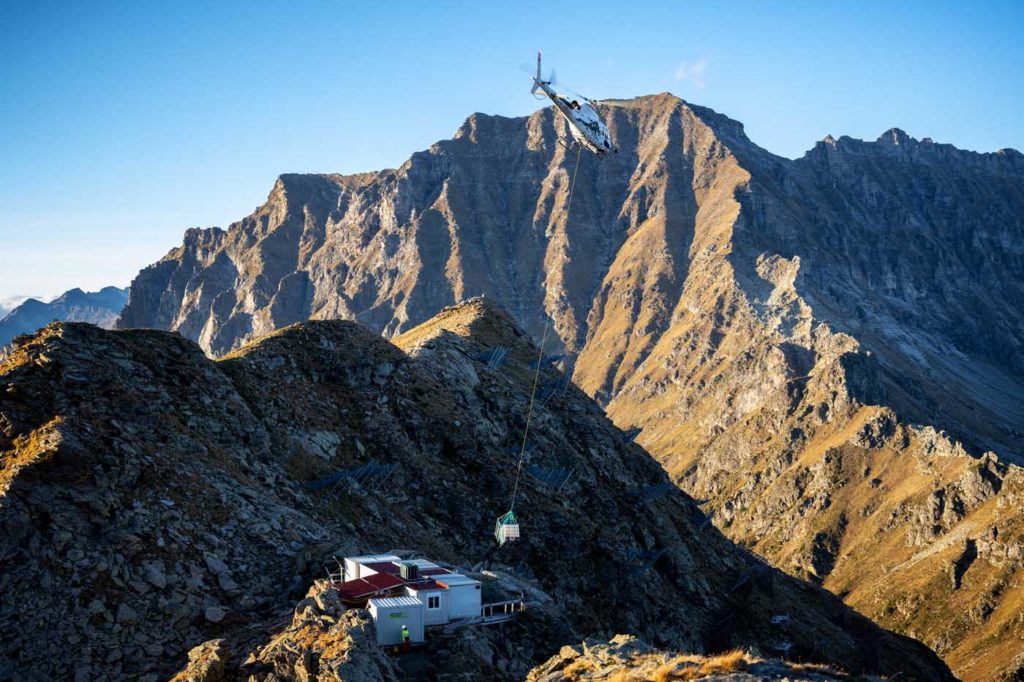
For those seeking relaxation of a more traditional kind, the Swiss Alps will always
be somewhere you can go to find the objects of health, wealth or happiness. And in the Italian-speaking region of Ticino, there’s a good chance they were delivered by Heli Rezia.






